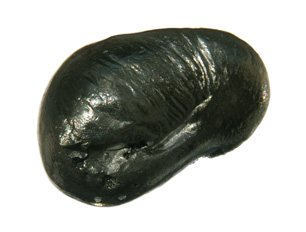Beryllium
| EPA Maximum Contaminant Level (MCL) |
0.004 mg/L |

A bead of pure beryllium.
Beryllium is an inorganic metal used in the weapons, aerospace and nuclear industries, and to make metal alloys for nuclear reactors, electronic equipment and microwave ovens. It enters surface and ground water naturally through the weathering of rocks and soils, or through human activity by way of industrial discharges and, primarily, through coal and fuel oil combustion.
According to the World Health Organization, beryllium is generally not a water treatment concern:
Beryllium is not likely to be found in natural water above trace levels as a result of the insolubility of oxides and hydroxides at the normal pH range.
Health Effects of Beryllium
Beryllium can cause intestinal problems with long term exposure. According to the EPA:
Some people who drink water containing beryllium well in excess of the maximum contaminant level (MCL) for many years could develop intestinal lesions.
Beryllium is also classified by the International Agency for Research on Cancer as a human carcinogen, although via inhalation exposure rather than ingestion.
Water Treatment for Beryllium
The EPA recommends activated alumina, coagulation/filtration, ion exchange, lime softening and reverse osmosis as treatment methods for beryllium.
Sources: EPA, WHO, Photo: images-of-elements.com
Site Index
Filtration Systems
- Aeration for Iron & Sulfide
- Backwashing Filters
(whole house & well units)
- Chlorine & Chemical Injectors
- Countertop Water Filters
- Garden Hose Filters
- Reverse Osmosis, Residential
- Reverse Osmosis, Commercial
- Shower Filters
- Specialty Filters
- Ultraviolet Systems
- Undersink Filters
- Water Softeners
- Whole House Filters
Cartridges
Parts
- Replacement Parts
- Faucets
- Filter Media
- Fittings
- Housings
- O-rings
- Pumps
- Pura UV
- R.O. Parts
- R.O. Tanks
- R.O. Booster Pump
- VIQUA UV